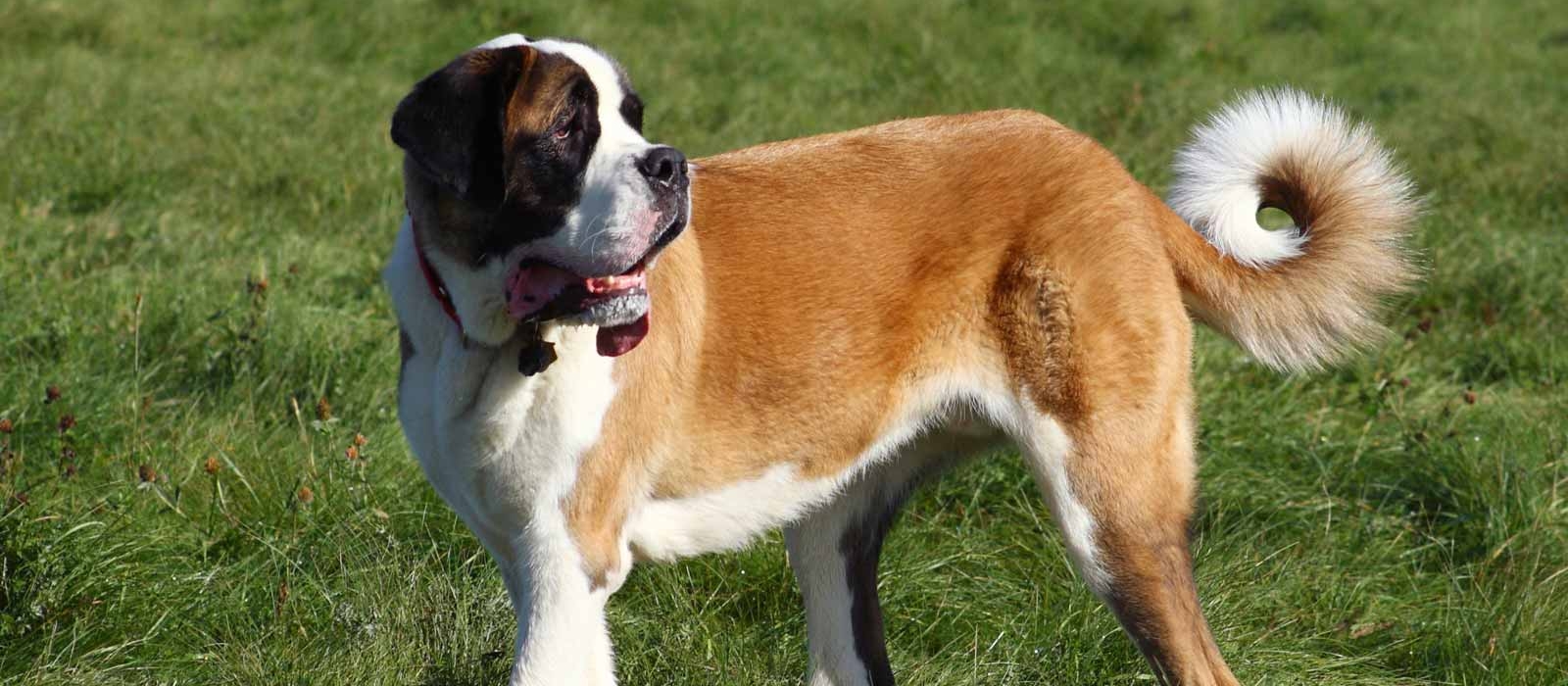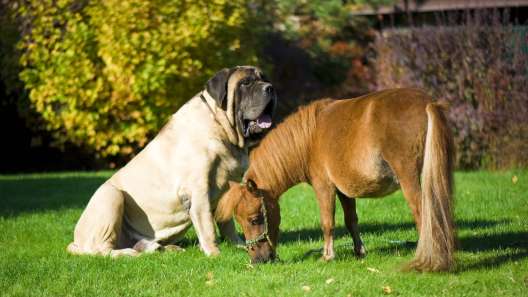-
Activity Level:
moderate
-
Shedding Level:
moderate
-
Grooming Level:
moderate
-
Trainability:
high
-
Good for Novice Owners:
high
-
Adaptability:
moderate
-
Kid/Pet Friendly:
often
-
Prey Drive:
low
-
Watchdog:
very alert
- Average Size: Giant
- Average Lifespan: 8-10 years
- Registered?: aca, akc
Saint Bernard Dog Breed Information
Overview
Temperament
Adaptability
Health
Owner Experience
Grooming
Activity Level
Size
Life Span
Did You Know?
The Saint Bernard originated in the Swiss Alps several centuries ago. As the story goes, the journey across the Alps was a treacherous one, so monks established a hospice to aid pilgrims from Rome who were braving the journey.
The establishment founding of 1050 is credited to Bernard of Menthon and the area came to be known as St. Bernard Pass or the Great St. Bernard Pass. These monks developed a working dog that was able to handle the harsh conditions and serve as a search and rescue dog for travelers lost or buried in the snowy landscape.
Hence, the dog breed we know as the Saint Bernard was born. In addition to search and rescue up in the mountains, they were also used for guarding and herding livestock as well as hauling goods in the farms and dairies located in the valleys. The American Kennel Club recognized the Saint Bernard in 1885. They are a member of the Working Group and are also one of the most popular dog breeds.
Saint Bernards are friendly, playful, and gentle giants. These dogs may be huge and imposing, but they are loving and loyal sweethearts. Well-socialized, they are one of the kid-friendly dog breeds that get along well with children, other dogs, and other pets.
So much so, that they are famously referred to as “nanny dogs” when it comes to children. They tend to be patient and often take on the roles of watchful guardian and gentle playmate. You do still need to be careful when they are puppies as they are still big and can accidentally knock someone over in their exuberance.
Although well-socialized Saint Bernards do tend to be open and friendly, they are protective of their families and will be initially wary of strangers until they are introduced. But, once introduced and it is clear you are a welcome guest, be prepared for some cuddles and drool as a Saint Bernard warms up and makes friends.
The Saint Bernard is a moderately adaptable dog breed. Although they can adapt to apartment living, their large size is often a challenge in smaller spaces. Because of this, they tend to be better suited to larger homes, especially those with yards and room to roam.
Although they are a cold-weather dog breed and are one of the dog breeds that love winter, they tend to do well in a variety of moderate climates. However they are sensitive to heat and can overheat easily, so may not be the best fit for hot or tropical climates. Because they bond so closely with their families and want to be near them, they do not like to spend long periods of time alone.
Potential health concerns to be aware of in a Saint Bernard can include eye disease, hip dysplasia, and elbow dysplasia. Good breeding practices make a big difference in the health of Saint Bernard puppies. Reputable breeders will screen their dogs to avoid passing preventable issues to puppies.
Make sure you ask about the health and genetic history of both parents. You can also ask about any health tests or clearances that have been done. The national breed club recommends a hip evaluation, an elbow evaluation, a cardiac exam, a Degenerative Myelopathy (DM – Common Variant) DNA test, and an ophthalmologist evaluation at a minimum.
As a giant dog breed, it’s important for a Saint Bernard to get enough nutrition and exercise as they are growing. It’s also important to keep their exercise relatively low-impact until puppies finish growing.
For Saint Bernard puppies, this is usually around 2 years old or more. Until this point, their bones and joints are still developing and too much, too soon can damage them. You can work with your vet to plan out when to expand activities as your Saint Bernard grows to avoid potential damage to their growing bones.
As large, deep-chested dogs, Saint Bernards are also at a higher risk for bloat. Because bloat in dogs can become life-threatening if the stomach flips, it’s important for owners to know how to reduce the risk and the signs to look for in order to get to the vet as quickly as possible.
The Saint Bernard is a highly trainable dog breed and tends to be a good fit for owners of all experience levels. They are intelligent and eager to please, which means they pick up on things quickly. Early training and socialization are important for any dog breed and there are some extras that are even more important to start early for large breeds.
Due to the size of the Saint Bernard, it’s essential to start training your dog not to jump up or knock over people, to teach them boundaries and clear expectations, and to start leash training. These dogs tend to respond quickly to commands once they know what is expected of them. Whether you are a first-time dog owner or have more experience, there are plenty of benefits of puppy training classes for both you and your dog.
Although the Saint Bernard coat comes in two versions, long-haired and short-haired, they both require about the same amount of care. This dog breed will shed moderately year-round and more heavily twice a year as the seasons change. For most of the year, weekly brushing is sufficient to keep your Saint Bernard’s coat healthy. During their heavier shedding sessions, you’ll want to increase to daily brushing. The occasional bath as needed is plenty for this dog’s coat.
In addition to coat care, you will also need to take care of your Saint Bernard’s nails, ears, and teeth. Cutting your dog’s nails on a monthly basis is usually sufficient to keep them from growing too long. If they’re not wearing down as much naturally, you may need to trim their nails more often. Checking your dog’s ears weekly and carefully cleaning them as needed can help prevent ear infections. When you’re looking at their ears, check to make sure they are clean, dry, and free of debris, and that there is no excess buildup of wax.
You will also want to make sure you are taking care of your dog’s teeth and gums early and consistently throughout your dog’s life. Dental disease is one of the most common health issues in dogs. It’s also one of the most preventable and good dental care for dogs should not be overlooked. Brushing their teeth or using an enzyme toothpaste for dogs every day is a good start. You can also supplement your efforts with dental hygiene chews approved by your vet and a specially-formulated “dental care diet”.
It’s important to get your Saint Bernard used to having their paws, ears, and mouth handled as a puppy. If you keep it a rewarding and positive experience, you can build a bond with your dog and make grooming a bonding experience for you both that your dog doesn’t mind or even one that they look forward to! This effort up-front will make basic grooming and maintenance so much easier as your dog grows.
Although they are a large working dog, the Saint Bernard only requires a moderate amount of daily exercise. Their daily walks plus some playtime are usually plenty to keep them happy and healthy. Because Saint Bernards love being with their families, they will be happy just to be spending time with you doing something together.
This can also result in them becoming one of the laziest dog breeds if you’re not active and they match their energy to yours, so you do want to make sure you’re getting enough activity every day with them.
Provided the vet clears them for it, try out some activities and see what they like; you might even discover a new activity you both love. Who knows? You may find that your Saint Bernard likes hiking with you, going camping with you, or going for a swim. Saint Bernards can even be found competing in drafting or carting competitions!
A fully-grown Saint Bernard usually stands 26-30 inches tall and weighs 120-180 pounds. Females usually average 26-28 inches tall and weigh 120-140 pounds while males usually average 28-30 inches tall and weigh 140-180 pounds.
Although this is the average general size range, the Saint Bernard is a giant dog breed and one of the largest dog breeds in the world. So, some individual dogs may run larger than the average. Some Saint Bernards have even weighed in at over 200 pounds!
Saint Bernards generally live for 8-10 years on average.
One of the interesting facts about Saint Bernards is that, before 1830, Saint Bernards were short-haired dogs. Due to a few years of severe weather and the breed dwindling, the monks began to cross them with longer-haired dogs, which gave us the addition of the fluffier long-haired Saint Bernards we know and love today.









